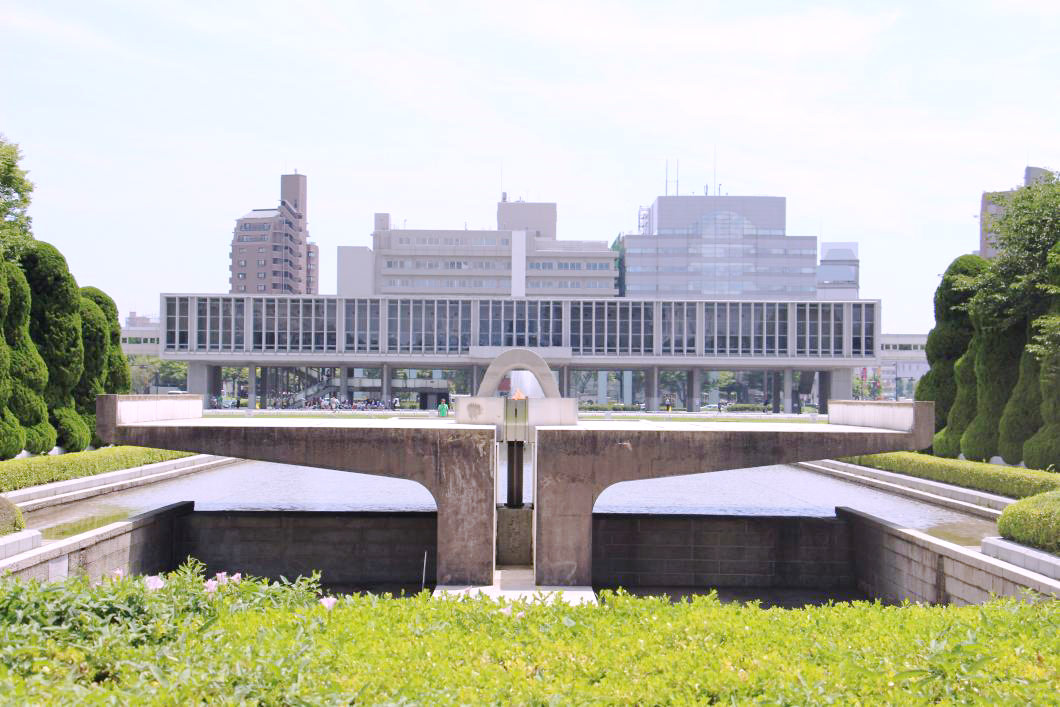The Hiroshima Peace Memorial Museum (広島平和記念資料館) is a museum located in Hiroshima Peace Memorial Park, in central Hiroshima, Japan, dedicated to documenting the atomic bombing of Hiroshima in World War II.
Hiroshima Peace Memorial Museum collects and displays belongings left by the Victims, Photos, and other materials that convey the horror of that event, supplemented by exhibits that describe Hiroshima before and after the bombing and others that present the current status of the nuclear age.
To facilitate education, the museum was renovated in 1994 and is now divided into two sections.
The East Wing—the newest addition—explains the history of Hiroshima City before the bomb, development and decision to drop the bomb, the lives of Hiroshima citizens during World War II and after the bombing, and ends with information about the nuclear age and efforts for international peace. Included in this section is a model showing the damage done to the city. It has some important letters exchanged between scientists and top leaders of that era talking about atomic development and predicted result of its use.
The West Wing, which was part of the old museum, concentrates on the damage of the bomb. Sections include Material Witness, which shows clothing, watches, hair, and other personal effects worn by victims of the bomb; Damage by the Heat Rays, a section that looks at what happened to wood, stone, metal, glass, and flesh from the heat; Damage by the Blast, focusing on the destruction caused by the after shocks of the blast, and Damage by the Radiation which goes into details about the health effects suffered by humans.
Main Building
On July 5, 2006, the Main Building was designated as the first national important cultural properties among the architectural buildings which were constructed after World War II. The Main Building designed by Kenzo Tange became the first post-war architectural structure which was highly appraised internationally. It is also recognized as a starting point of Tange’s career.
East Building
Steel-framed reinforced concrete construction, 3-storied with one basement building. It comprises exhibition rooms, a video theater, a memorial hall, meeting rooms, a library, storage rooms, offices, and a lobby as well as a resting room, Museum Shop, and other facilities, which are also open to visitors to the Peace Memorial Park.
Completing its renovation, the former Hiroshima Peace Memorial Hall which was constructed in 1955, reopened as the East Building of the Hiroshima Peace Memorial Museum in June 1994.
The East Building plays an underpart to the Main Building and is therefore rather modestly designed. In addition, the East Building is connected to the Main Building by a bridge corridor, and on the other side of the Main Building is another bridge corridor that connects to the International Conference Center that stands bilaterally symmetrical to the East Building. Furthermore, compared to the Main Building, which serves as a gateway to the Museum, the East Building is designed with a respectively heavy appearance; the posts and the beams are pitched with stone while free-standing walls, also pitched with stone, are fencing the building.
History:
1945 August 6, An atomic bomb detonates at approximately 600 meters over downtown Hiroshima. Severely devastated, Hiroshima became the world’s first city to be attacked by an A-bomb.
1949 August 6, The Hiroshima Peace Memorial City Construction Law is promulgated after receiving over 90 percent support in Japan’s first public referendum.
1949 September, The A-bomb Reference Material Display Room (A-bomb Memorial Hall) is established in the Hiroshima Central Public Hall. This is the first public display of atomic bomb materials.
1952 March, It is decided that, under the Hiroshima Peace Memorial City Construction Law, the Peace Memorial Hall, Peace Memorial Museum, City Auditorium, and the Cenotaph for the A-bomb Victims will be constructed in Peace Memorial Park as reminders of the past and contributions to a future of lasting peace.
1955, The Peace Memorial Hall and the Peace Memorial Museum open.
The volunteer citizen group A-bomb Materials Collection Support Association (now, A-bomb Materials Preservation Association) leads an effort that involves many Hiroshima residents in the gathering of materials related to the atomic bombing.
1958, The Hiroshima Restoration Exposition is held in and around the Peace Memorial Museum.
1975, In order to repair the aging structure and keep the materials from deterioration, the first large-scale renovation occurs and the exhibits are redesigned.
1991 August, A second renovation occurs and a large-sized model and big-screen videos are installed.
1994 June, Peace Memorial Hall is renovated to improve its functions of display and storage, and to provide more space for peace education. After its renovation, the Peace Memorial Hall reopens as the Hiroshima Peace Memorial Museum (East Building).
East Building…Hiroshima before the A-bombing, Development of the A-bomb and its dropping, Nuclear Age, Hiroshima’s Peace Promotion Activities
Main Building…Artifacts including belongings of the A-bomb Victims and Photographs.
2006 July, The Main Building was designated as the first national important cultural properties among the architectural buildings which were constructed after World War II.
2012 November, The Schmoe House opens as an annex of the Museum at 1-2-43 Eba-nihommatsu, Naka-ku, Hiroshima City.
2014 March, Renovations to the East Building and Main Building are launched.
2017 April, The East Building reopens after the renovation and the Main Building is temporarily closed.
The East Building comprises three exhibitions: “Introductory Exhibit,” “The Dangers of Nuclear Weapons,” and “Hiroshima History”.
At the Library, visitors can learn about the atomic bombings and peace related matters through books, magazines, and video testimonies recorded on DVDs, etc. If you have any questions, please feel free to ask the staff.
The museum was established in August 1955 with the Hiroshima Peace Memorial Hall (now the International Conference Center Hiroshima). It is the most popular of Hiroshima’s destinations for school field-trips from all over Japan and for international visitors. 53 million people had visited the museum from its opening in 1955 through 2005, averaging over one million visitors per year.
